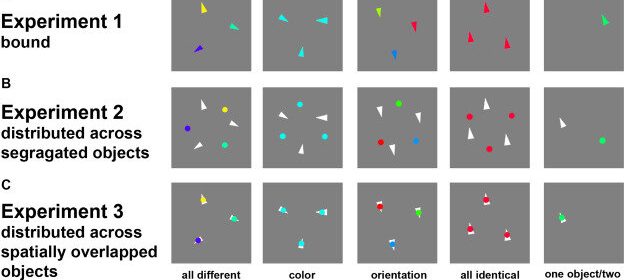Working memory is structured hierarchically

Researchers in cognitive psychology at HSE University have experimentally demonstrated that the colors and orientations of objects are stored and processed independently in working memory. However, it is easier for a person to remember these features when they belong to a single object: for example, it is easier for a person to remember and understand one graph on which both parameters are indicated (with a color and a line shape, for example), than two different graphs in which the two parameters are shown separately.
The results of the experiment were published in Acta Psychologica
Studies of working memory have been conducted since the last century. Working memory allows us to store and process information for a short period of time. A study by Steven Luck and Edward Vogel showed that it is possible to retain information on about 4 colors or orientations in visual working memory at one time, and that this information is stored in a bound way, i.e., changes in the quantity and complexity of objects’ features do not affect the storage capacity of visual working memory. However, subsequent studies have shown that working memory can store features independently of each other.
At HSE University, a team comprised of Yuri Markov, Natalia Tiurina and Igor Utochkin, studies the processes of visual perception at HSE’s Laboratory for Cognitive Research.
“In this study, we wanted to learn how information is stored in working memory, in particular, whether there are separate ‘shelves’ for storing color and information about the orientation of an object. We wanted to see how this storage manifests itself, firstly, when the color and orientation belong to one object, and secondly, when they belong to different objects,” said Yury Markov, a research assistant at the Laboratory for Cognitive Research at HSE.
The team conducted three experiments to study this problem. Participants were asked to memorize and then recall the color and orientation of objects. In the first experiment, color and orientation were features of a single object (e.g., a colored triangle); in the second experiment, these features pertained to different objects (e.g., a colored circle and a white triangle); and in the third experiment, the features pertained to different objects, but they were superimposed onto one another (e.g., a colored circle over a white triangle).
In all three experiments, participants were offered various sets of objects: for example, objects with different colors and orientations, those with the same color and different orientations, those with different colors and the same orientation, or those with the same color and the same orientation. The results showed that when objects shared one of the features, it did not help subjects memorize another feature. This suggests that features are stored independently in working memory.
However, the researchers observed a decrease in precision when subjects were asked to recall the colors of circles and the orientation of triangles as opposed to recalling both features of a single object.
“These results suggest that working memory is most likely structured hierarchically: objects are stored at one level, while their features are stored at a different level. This makes memorizing information pertaining to a single object easier,” Yury Markov noted.
Source: Read Full Article
